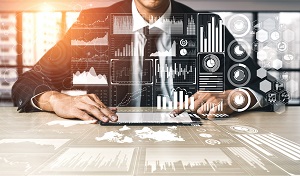Security and safety are the sum of many decisions
The decision-making processes, operating models and real-time information required by companies and organizations vary from event to event. For example, in a fire alarm situation gathering the information, communication channels used and the speed of the decision-making are completely different than when preparing for a sudden power outage.
The amount, scope and depth of the information required for the decision-making also varies at different levels of the organization.
Different operating environments set their own requirements for information sharing. The more departments, sites, and companies in the target group, the more complex the sharing becomes.
Often there is no shortage of the data itself. On the contrary, the data is widely available, but it does not yet guarantee good and quick decisions. So how do you turn the data into decision-making information for the use by those who need it in a timely manner in the different operating environments?
The challenge has been given, how to respond to it
Let's start by harmonizing the big data so that the information from different sources can be processed efficiently and in real time. All the data must be accessible through a single interface based on the access rights. Not only do users have access to the data, but they also have access to the pre-enriched and visualized - yet real-time - information from which deviations and trends are easy to spot.
For example, operational and technical deviations resulting from the events and functionality of the sensors, devices, systems, events, and alarms at Company A sites are automatically highlighted. These deviations are visualized on the map, grouped by the device / network / brand, etc. and of course, by the sites. From each deviation you can drill down to the actual failure.
With the help of the artificial intelligence, the routine operational processes and decision-making are automated. The deviations need various operational procedures which can be instructed (SOP) and / or automated. For example, events, alarms, and faults can be scored and prioritized according to their criticality. The two-way connectivity allows other systems and devices to be controlled automatically.
Let's continue with the Company A in the previous example. From each deviation, the information and operating instructions are automatically sent to the selected persons, who may also be external service providers. The system automatically receives information after each situation returns to normal. By combining from a variety of sources received information like a fault status, criticality, a device, a location, a fault repair, and a promised service level, the system automatically generates SLA reports for the Company A by the site and by the service provider.
The big data is screened and combined to provide automatically and in real time the information needed by the decision maker.
In the case of the Company A its security and IT departments have information on the distribution of the events, alarms and faults by the system, site, criticality, and duration etc. for the specified time. With the help of the information, it is easy to create plans for development, upgrading, and investments, make improvement suggestions, select development areas, modify criticality requirements, and make also quick changes to improve process results. Because the system can combine information from separate functions, in this example data owned by the security and IT departments, a more comprehensive company level situation awareness and a view to causes and consequences are achieved, and thus better conditions created for the decision-making.
Even if information sharing increases and the company’s information management becomes more efficient, the information will still remain secure, as everyone will have access to the information based on their access rights.
The information that individuals need in their own work can be found in BI reporting. BI reports can be distributed automatically to specified recipients. The information on the dashboard is updated in real time and automatically. Both BI reports and dashboards are built according to the individual needs of the users, so everyone can successfully utilize the information in their own work.
